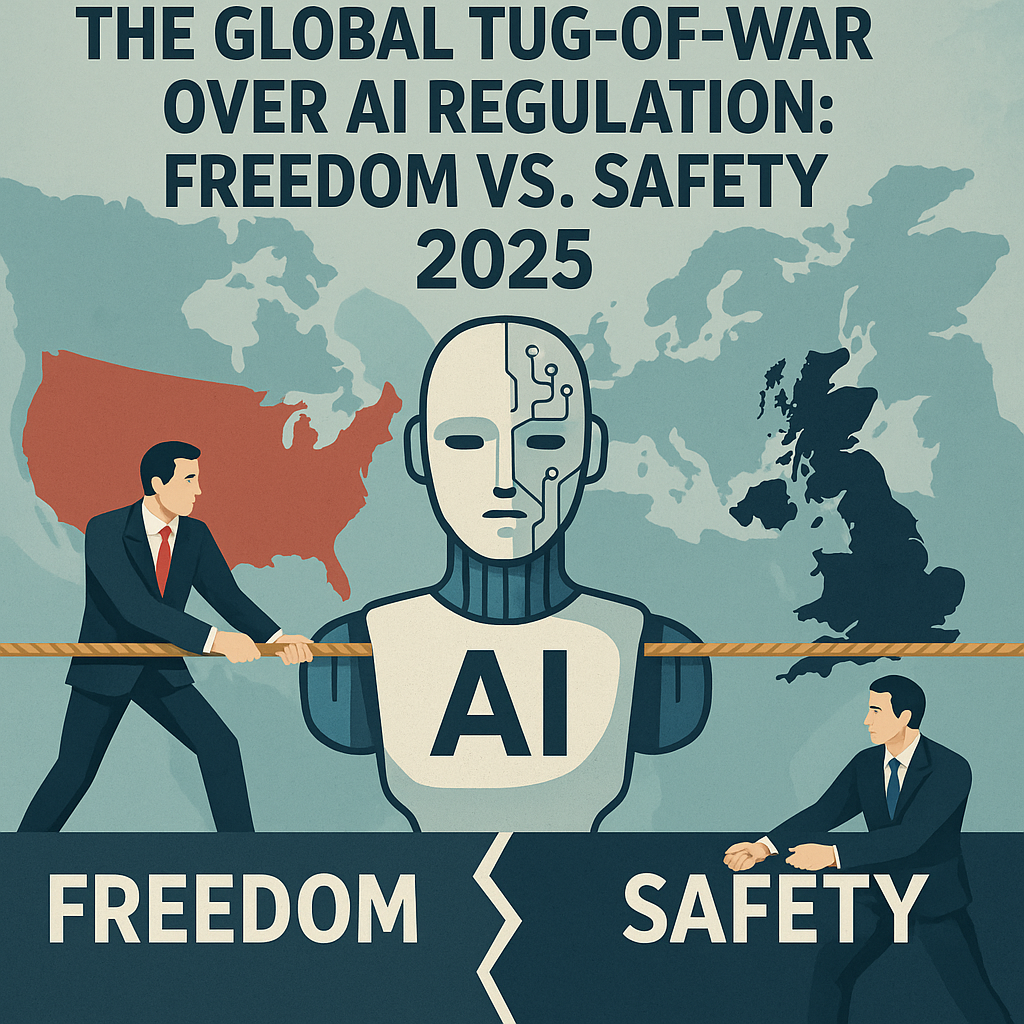Keywords: AI regulation 2025, US AI policy, UK Online Safety Act, AI ethics, global AI governance, AI freedom vs safety, Trump AI order, AI censorship, international AI law
🚀 Introduction
Artificial Intelligence (AI) is no longer a distant vision—it’s our everyday reality. From healthcare diagnostics to creative content, from autonomous vehicles to intelligent chatbots, AI is transforming how we live, work, and think.
But as the AI revolution gains momentum, one critical question dominates the global conversation:
Should AI be free to evolve with minimal restrictions—or should governments impose strict safety nets to protect people and society?
Welcome to the global tug-of-war over AI regulation—a rapidly escalating debate that’s pitting freedom against safety, innovation against ethics, and national strategies against international cooperation.
The U.S. Approach: Deregulate, Dominate, Deploy
On July 24, 2025, former U.S. President Donald Trump signed a bold executive order titled “Winning the AI Race.” The order aims to:
- Reduce federal restrictions on AI development
- Promote AI exports and global adoption
- Encourage a “national standard” overriding state-level regulations
- Strip out “woke” elements and “bias corrections” in AI systems
Critics say this deregulation could lead to unchecked misinformation, algorithmic bias, and loss of ethical oversight. But supporters argue it will supercharge U.S. innovation, reduce bureaucracy, and boost global competitiveness.
The UK’s Stance: Prioritize Safety, Especially for Children
On the same day, the UK Online Safety Act came into effect. It mandates:
- Age verification for adult content
- Strict protections for children on social media
- Accountability for digital platforms hosting harmful content
This reflects the UK’s safety-first approach, focused on preventing online abuse, protecting minors, and reducing AI-generated risks such as deepfakes and cyberbullying.
⚖️ The EU & China: Somewhere In Between
- The EU’s AI Act is the most comprehensive attempt at classifying AI based on risk levels, with heavy regulation for “high-risk” applications like facial recognition and biometric surveillance.
- China, on the other hand, mixes tight control with state-led innovation, monitoring both ethical AI use and ideological alignment with national goals.
🌐 Why This Divide Matters Globally
| Area | U.S. Model | UK/EU Model |
|---|---|---|
| Innovation Speed | Fast & unregulated | Slow & cautious |
| Ethical Safeguards | Low priority | High priority |
| Start-up Friendliness | High | Medium to Low |
| Consumer Protection | Limited | Strong |
These stark differences affect:
- Global AI investments
- Cross-border compliance for tech companies
- Open-source vs. proprietary development
- Talent migration between countries
🤖 What Does This Mean for the Future of AI?
We’re approaching a fragmented AI world, where:
- U.S.-based apps may prioritize speed and scale
- EU/UK apps may offer better trust and transparency
- Startups will need to navigate a maze of regional laws
- Ethical dilemmas—like racial bias, misinformation, and job automation—will become battlegrounds for public policy
💡 Final Thoughts: Can We Have Both Freedom and Safety?
The real challenge isn’t choosing between freedom or safety, but finding a sustainable balance. Innovation thrives in freedom—but without ethical guardrails, it can spiral into danger. Meanwhile, overregulation can smother creativity and drive talent away.
The global AI race isn’t just about technology—it’s about values, leadership, and vision. The world must collaborate—not compete blindly—if we hope to build an AI future that’s fast and fair.
📢 Call to Action
Are you a developer, policymaker, or digital enthusiast?
🌐 Stay informed. 🧠 Stay ethical. 🛠️ Build responsibly.
Let’s shape AI—not just let it shape us.
